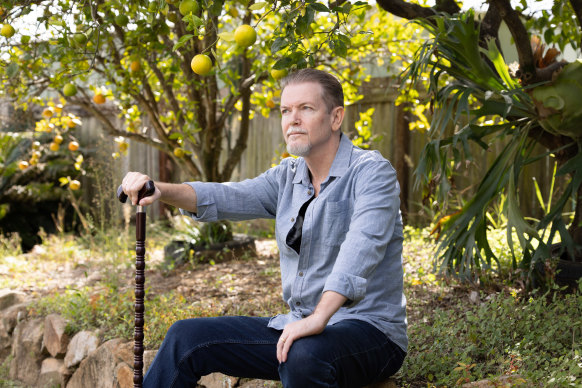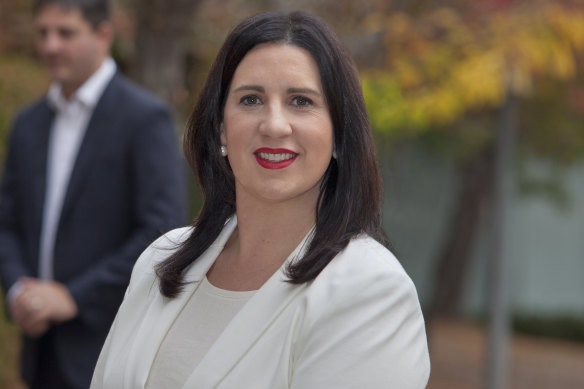‘A very dark time’: When his doctor changed his prescription, the effect for Kevin was instant

Save articles for later
Add articles to your saved list and come back to them any time.
After being taken off the opioids he’d been using to manage his back pain for three years, Kevin James thought about taking his own life.
“I developed post-acute withdrawal syndrome, insomnia and pain which exacerbated mental health problems,” he said. “It was a very dark time, and I am lucky to still be alive.”
Chronic pain sufferer Kevin James said a doctor’s decision to reduce his opioid medication took a major toll on his physical and mental health. Credit: Paul Harris
James developed facet disease in 2013. Similar to arthritis, it leads to degenerative damage to joints around the spine, causes pain and limits mobility. Three years later he was prescribed opioids after visiting a pain clinic, taking a low dose of the synthetic opioid Palexia – a drug not usually recommended for treating chronic pain.
The Brisbane-based chronic pain patient advocate says he is bedridden without his medication. “I’m extremely happy if my pain is at four or five out of 10 every day. But if I don’t have opioids, it’s a seven, eight or nine,” he said.
But in 2019 amid a regulatory push to limit opioid prescriptions, his doctor decreased his dosage by 25 per cent, before tapering him off them. “My doctor put me back on the correct amount several months later, but the damage was done,” he said. “It took me about two years to get back to being myself again.”
James is concerned the first national guidelines aimed at reducing or discontinuing opioids in primary care, set to be publicly released this week, will limit access to medication for chronic pain sufferers.
Australia has been reassessing its relationship with pharmaceutical opioids since 2016 when opioid deaths hit 1119 – the highest number since 1999 – with 3.1 million Australians prescribed one or more opioids.
The Penington Institute has warned the nation faces the same opioid epidemic as the US. The number of unintentional drug-induced deaths involving opioids has tripled since 2006 with 856 deaths in 2020, according to the organisation’s latest annual overdose report.
The government has responded with a range of methods to curb the number of opioid-related deaths, establishing the Opioid Regulatory Advisory Group in 2018, which recommended a series of legislative changes, including introducing smaller pack sizes to limit unused opioids; adding warning labels to medication packaging and introducing state-based real-time prescription monitoring schemes.
The Therapeutic Goods Administration also messaged health professionals about best prescribing practices and sent letters to GPs who were in the top 20 per cent of prescribers of opioids. The crackdown led to a sharp drop in opioid prescriptions. Between 2016 and 2021 opioid medicine dispensing rates were reduced by 18 per cent, with a 30 per cent reduction in the overall volume of opioid medicines dispensed.
And in September last year, the National Health and Medical Research Council approved evidence-based clinical practice guidelines for taking patients off opioids.
But chief executive of Pain Australia Giulia Jones said there was still a place for opioid use, provided they were prescribed “carefully and sensibly”, and raised concerns about regulations limiting pain medication. “There is a large group of people who are very distressed about changes that occurred,” she said.
Opioids have been shown to reduce chronic pain not related to cancer, though only slightly. The Therapeutics Goods Administration recommends opioids only be used in “exceptional circumstances” or for “as-needed” non-cancer pain relief.
Giulia Jones from Pain Australia says there is still a place for prescribed opioids.
University of Sydney School of Pharmacy Associate Professor Danijela Gnjidic, who helped develop the guidelines, said they provided a pathway to stopping or reducing opioids from the moment they’re prescribed, with regular reviews.
“It’s a person-centred approach to help someone taper off opioids if they choose to do so, and to empower patients,” she said. “These guidelines aren’t there to say ‘stop opioids’, they’re there to help clinicians, GPs and patients to work together to identify the most appropriate approach to reducing opioid use over time.”
Pharmaceutical opioids are responsible for more deaths and hospitalisations than heroin or methadone. In 2016, over half of people using painkillers and opioids for non-medical purposes bought them over-the-counter at the pharmacy, while one in five obtained them with a medical prescription.
“These guidelines aren’t there to say ‘stop opioids’, they’re there to help clinicians, GPs and patients … to [reduce] opioid use.”
The dangers of opioids aren’t well known among patients, with a 2020 TGA report finding less than half of all opioid consumers were aware they were taking an opioid medication, while just 17 per cent reported they weren’t dependent on their medication.
People with opioid addiction have higher rates of suicide and self-harm than the general population, with one study finding nearly one in 10 people with the disorder presented to the hospital for self-harm in NSW.
But those with chronic pain are also at least twice as likely to report suicidal behaviours and may face higher risk of self-harm if taken off opioids.
US data has shown stopping opioid treatment among veterans was associated with an increased risk of death from overdose or suicide, especially among long-term users.
US data has found the removal of opioid treatment has had adverse consequences for US veterans.Credit: The Brownsville Herald
Australia has yet to collect data on the link between discontinuing opioid prescriptions, overdoses and mental health crises. However, Deputy Director of the Monash Addiction Research Centre Professor Suzanne Nielsen said the international data highlighted the need to “proceed with caution”.
Nielsen also said a “concerning” emerging trend following the reassessment of opioid medication use was the increase in heroin-related mortality. “There is some evidence to suggest that we may have pushed some people away from the medical system and towards illicit opioids,” she said.
Heroin consumption has increased by 10 per cent between 2021 and 2022 and is now the second most consumed illicit drug after methylamphetamine.
Nielson is “hopeful” the new guidelines will have good outcomes as they emphasised the importance of collaboration with patients, and may help identify patients with opioid use disorder, and refer them to specialist treatment.
In the last financial year, around 131,000 Australians sought alcohol and drug treatment. “There have been estimates that we needed to double the number of treatment places in Australia to mean that everybody who needs treatment can access it,” Nielson said.
Neen Monty was first prescribed opioids eight years ago for mixed connective tissue disease, arthritis, and spinal disease ankylosing spondylitis.
Following surgery in 2020, she suggested to her GP her opioids be tapered, reducing her dose from 40 milligrams to 10. But her pain returned, and she asked to be returned to her original dose. Monty said her GP refused, and planned to take her off opioids altogether.
“I tried all these alternative medications but for me, they were horrible,” she said. The medications caused weight gain and fatigue and her pain remained at high levels.
Monty, who lives in Canberra where she runs two small businesses and cares for her son, is back on 20 milligrams and combines opioids with daily exercise, meditation and hot and cold packs.
“I’ve done all the pain education … but if you take my pain medicine away, there’s really nothing I can do except lie in bed and feel terrible. That’s not a life,” she said. “When you know there’s a treatment that can reduce that pain and that you can have a life, that people won’t give it to you … it’s torturous.”
Doctors are encouraged to offer alternatives when taking patients off opioids, but Jones said that didn’t happen for a number of consumers. “Some of those people still haven’t found a replacement option or an alternative.”
A 2022 survey conducted by Pain Australia found 59.6 per cent of respondents reported difficulties in accessing any treatment options for their pain management. The organisation receives research grants from pharmaceutical companies. Forty-three per cent reported that their health professional did not offer an alternative treatment or support for them to manage their pain.
Between 2016 and 2018 the median wait time for a persistent pain service was 60 days, though some clinics had wait times of up to three years.
Pain Australia supports multidisciplinary pain management, consisting of psychological training, physical movement – and, for some, medicines. The intention isn’t to be on strong pain medications every day, Jones said, but to have them available during flair-ups. “The pain consumer is vilified. You wouldn’t wish chronic pain on your worst enemy, yet we just dismiss it and pretend people are exaggerating.”
Lifeline is on 13 11 14.
The Morning Edition newsletter is our guide to the day’s most important and interesting stories, analysis and insights. Sign up here.
Most Viewed in National
From our partners
Source: Read Full Article



